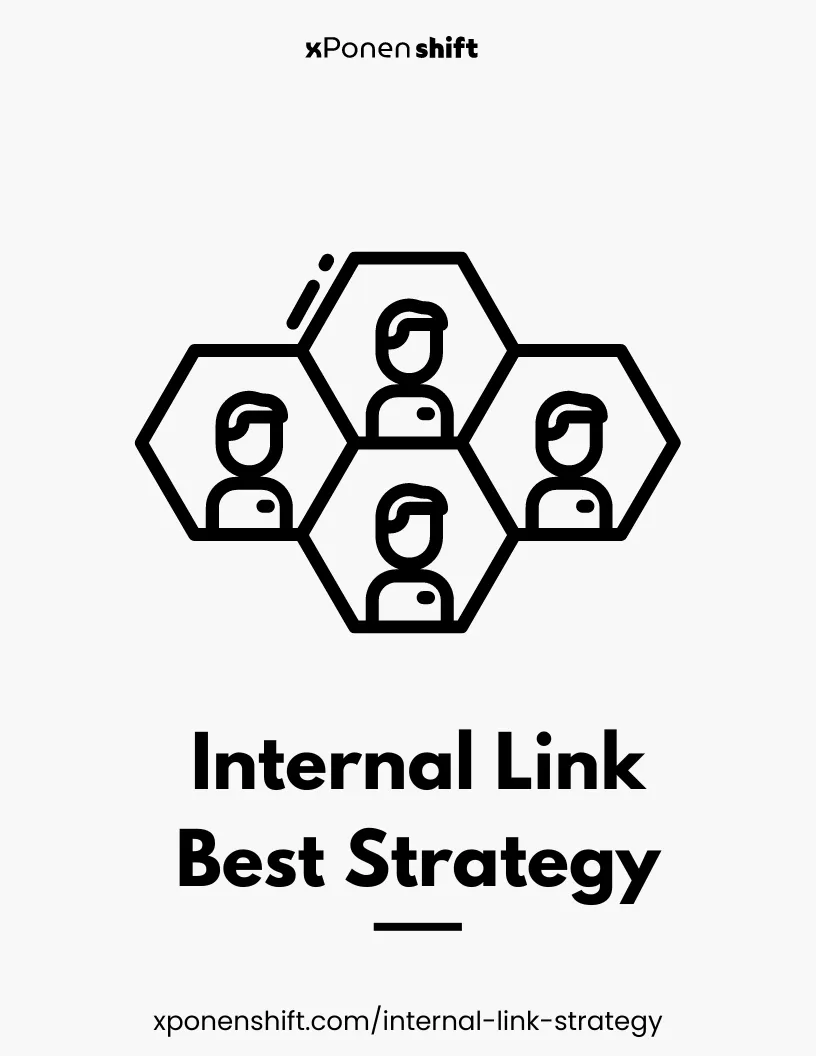- admin
- On-Page SEO
- 0 Comments
- 5766 Views
Internal linking refers to the practice of linking one page of a website to another page within the same website.
This strategy is crucial for SEO (Search Engine Optimization) because it helps spread link equity (ranking power) around websites, which can boost the ranking of important pages.
Moreover, internal links make it easier for search engines to crawl and index a website, and they improve the user experience by providing readers with further reading options.
The general goal of an internal linking strategy is to guide users and search engines to important pages that might otherwise go unnoticed.
Do Internal Links Have to Point to Pages Within the Same Website? Can They Point to Other Websites?
Internal links are specifically designed to connect pages within the same website. The purpose is to help navigate the site, organize the site structure, and distribute page authority and ranking power throughout the site.
If a link directs a user to a page on a different website, it is called an external link, not an internal link. External links are also valuable for SEO as they can establish trust and relevancy, provide value to your readers, and potentially lead to reciprocal links or other partnerships.
How to Create an Effective Internal Linking Strategy?
Creating an effective internal linking strategy involves several key steps. Firstly, ensure that the links are relevant and useful, linking pages that offer related content.
This improves the user experience and helps search engines understand the context and relationship between pages.
Secondly, use descriptive anchor text that indicates the content of the target page, which can boost SEO by aligning with relevant keywords.
It’s also important to maintain a reasonable number of links per page to avoid overwhelming users and diluting link value.
Finally, regularly check and update internal links to fix broken links and adjust the strategy based on the evolving content and SEO goals of the website.
This systematic approach helps to maximize the SEO benefits of internal links while enhancing site navigation and user engagement.
Example of Using Semantic Anchor Text for an Apartment Rental Niche
Before Adding Links:
Imagine you have a webpage discussing tips for first-time apartment renters. The text reads:
“Understanding your budget is crucial before starting your apartment hunt.”
After Adding Links with Semantic Anchor Text:
Now, let’s integrate a relevant internal link:
“Understanding your budget considerations is crucial before starting your apartment hunt.”
In this modified sentence, the link with the anchor text “budget considerations” could lead to another page on your site that details how to plan and manage a budget for renting an apartment.
Another Example:
Before Adding Links:
Another section of the site might discuss apartment amenities:
“Check for essential amenities while apartment hunting.”
After Adding Links with Semantic Anchor Text:
This could be updated to:
“Check for essential apartment amenities while apartment hunting.”
Here, “essential apartment amenities” would link to a page that lists and explains common amenities potential renters should consider.
These examples show how to use descriptive and relevant semantic anchor texts that add value to the text and guide users to additional useful content, enhancing both their experience and the SEO of your website.
In a paragraph discussing the process of finding the right apartment, you might have:
Before Adding Links:
“When looking for an apartment, it’s important to consider location, price, and the type of lease. Make sure the area is safe and that it has easy access to public transportation. Additionally, review the lease terms carefully to ensure they meet your needs and understand the costs involved, including any security deposits or utility fees.”
After Adding Links with Semantic Anchor Text:
Here’s how you could enhance the paragraph with internal links:
“When looking for an apartment, it’s important to consider location preferences, price range, and the types of leases available. Make sure the area is safe neighborhoods and that it has easy access to public transportation options. Additionally, review the lease terms carefully to ensure they meet your needs and understand the costs involved, including any security deposits or utility fees.”
In this revised paragraph, each bolded phrase is a semantic anchor text linking to different pages that provide more detailed information on each topic, such as detailed guides on evaluating locations, understanding leasing types, and what to expect with security deposits.
This not only enriches the content’s SEO potential but also improves navigability for users seeking more specific information.
The best way to design internal links
To perform an effective analysis of internal links for posts related to selling cluster homes, you can create a table that helps track various important elements of each link. Here’s a basic structure for such a table, including example entries for hypothetical articles or product pages about cluster homes:
| Page URL | Linking Page URL | Anchor Text | Link Type | Purpose of Link |
|---|---|---|---|---|
| /cluster-homes-for-sale | /buying-a-home | Cluster Homes for Sale | Informational | Direct users to sales listings from informational content. |
| /financing-options-for-homes | /cluster-homes-for-sale | Financing Options | Transactional | Provide financing information on sales page. |
| /home-maintenance-tips | /cluster-homes-for-sale | Maintenance Tips for Homes | Informational | Offer maintenance advice to potential buyers. |
| /cluster-home-designs | /advantages-of-cluster-homes | Latest Cluster Home Designs | Informational | Show design options to convince potential buyers. |
| /advantages-of-cluster-homes | /why-choose-cluster-homes | Benefits of Cluster Homes | Persuasive | Explain the advantages of cluster homes. |
How to Use This Table
- Page URL: This is the target page where you want the traffic to go.
- Linking Page URL: This is the page on your website from which the internal link originates.
- Anchor Text: This should be descriptive and keyword-rich, reflecting the content of the target page as well as integrating relevant search terms.
- Link Type: Defines whether the link is informational (providing more information), transactional (leading to a purchase or inquiry), or persuasive (aiming to convince).
- Purpose of Link: A brief explanation of why this link is placed here and what it aims to achieve in the context of the user’s journey on the site.
This table can be populated and expanded as you analyze and strategize the internal linking across your website, ensuring each link serves a specific purpose and enhances the SEO as well as user experience.
Imagine you are managing a website focused on real estate, specifically targeting sales of cluster homes. Here’s a paragraph for a blog post titled “Why Choose Cluster Homes?” with strategic internal links incorporated:
“In today’s real estate market, choosing the right type of home is crucial. Cluster homes offer numerous benefits, including enhanced security, community living, and often, more affordable maintenance costs. For those interested in exploring available properties, our comprehensive listing of Cluster Homes for Sale [link to: domain.com/cluster-homes-for-sale] provides a variety of options to suit different needs and preferences. Additionally, understanding the financial aspects is key, so be sure to check out our detailed guide on Financing Options for Homes [link to: domain.com/financing-options-for-homes]. Moreover, maintaining your home shouldn’t be a hassle; our Maintenance Tips for Homes [link to: domain.com/home-maintenance-tips] can help ensure your property remains in top condition.”
In this paragraph:
- The link Cluster Homes for Sale directs readers to the sales listings, encouraging them to explore specific offerings.
- Financing Options for Homes provides critical information that aids potential buyers in planning their finances effectively.
- Maintenance Tips for Homes offers valuable advice, enhancing the post-sale user experience and providing ongoing value to homeowners.
This setup not only guides the reader through a logical sequence of thought but also strategically positions the internal links to maximize user engagement and SEO benefits.
Is it necessary to make decorative text in the anchor text of the link?
Decorating text for anchor links, such as using bold or italic styles, depends on the specific goals of your content and the user experience you want to create.
Generally, the primary purpose of formatting anchor text is to make it stand out from the rest of the text, guiding readers towards important resources or pages.
This can enhance navigation and make the content more user-friendly.
Reasons to Decorate Anchor Text:
- Visibility: Making anchor text bold or using a different color can help it stand out, making it easier for users to notice and click on.
- Usability: Highlighting anchor text can improve the overall readability of the content and make the web experience more intuitive.
- Design Consistency: Depending on the design of the website, you might want to maintain a consistent style that fits well with the rest of your site’s aesthetic.
Example Explanation:
In the previous example where anchor texts like Cluster Homes for Sale were made bold:
- The bold formatting was primarily used to illustrate the example clearly and show how anchor texts can be emphasized within a content piece.
- In practice, whether you choose to bold, italicize, or color the anchor text should align with your website’s design guidelines and what you find most effective in engaging your readers.
It’s important to maintain a balance; the anchor text should be noticeable but not disruptive to the reading experience.
The styling should encourage clicks without appearing overly promotional or out of place with the rest of the content.
Conclusion
Internal linking is a crucial strategy in SEO that involves linking pages within the same website. It enhances site navigation, improves page authority, aids in website indexing by search engines, and enhances user experience by guiding visitors to relevant pages.
Effective internal linking involves using descriptive and relevant anchor texts that reflect the content of the linked pages.
The choice of anchor text and its decoration, like bold or italic formatting, should be made with an eye toward enhancing visibility and readability, fitting seamlessly into the site’s overall design.
To implement an effective internal linking strategy, it is important to maintain a structured approach by mapping out links that add value, using a table to track links and their attributes, and ensuring that each link serves a clear purpose.
This systematic approach not only boosts SEO performance but also supports a coherent user journey through your website, making critical information easily accessible and improving the overall user experience.



